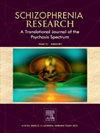Effects of an unguided self-help intervention for distressing auditory verbal hallucinations in a heterogenous sample of voice hearers: A randomized controlled trial and explorative cluster analysis
IF 3.5
2区 医学
Q1 PSYCHIATRY
引用次数: 0
Abstract
Objective
Clinical care and research need to improve treatment availability for auditory verbal hallucinations (AVH). To provide further evidence, we examined the efficacy of an unguided six-weeks self-help intervention for AVH (MCTVoice) based on metacognitive training.
Methods
N = 78 participants with distressing AVH were recruited from clinical and non-clinical settings. We conducted a randomized controlled trial (RCT) that compared the MCTVoice with a waitlist control group (WLcontrol), both receiving additional treatment-as-usual. Outcomes were the frequency and distress of AVH, general hallucinatory and psychiatric symptoms, quality of life, and satisfaction with the intervention, following an intention-to-treat (ITT) and per-protocol (PP) principle. Besides, we conducted an explorative cluster analysis to examine subgroups of voice hearers.
Results
We found no significant differences between the groups on the frequency and distress of AVH. However, general hallucinatory experiences were significantly reduced in the MCTVoice compared to the WLcontrol group in PP-data (F(3,48) = 39.51, p = .038, η2p = 0.09). No other between group comparisons were significant. The cluster analysis revealed a two-cluster solution with a higher (type 1) and a lower (type 2) symptom burden group, with higher values of clinical and AVH characteristics in cluster 1. Besides, participants in cluster 1 showed significantly greater improvements in AVH compared to cluster 2 (F(1,44) = 7.97; p = .007, η2p = 0.15).
Conclusion
Even though we found no effect of the MCTVoice on the main outcome, results showed promising outcomes on general hallucinatory experiences in PP data. The identification of AVH clusters could contribute to implement individualized interventions that target specific characteristics and needs of voice hearers.

在异质听话者样本中,无指导自助干预对痛苦听觉言语幻觉的影响:一项随机对照试验和探索性聚类分析
目的临床护理和研究需要提高听觉言语幻觉(AVH)的治疗可得性。为了提供进一步的证据,我们研究了基于元认知训练的无指导的六周AVH自助干预(MCTVoice)的有效性。方法从临床和非临床环境中招募78例苦恼性AVH患者。我们进行了一项随机对照试验(RCT),将MCTVoice与等候名单对照组(wl对照组)进行比较,两者都接受了常规的额外治疗。结果是AVH的频率和痛苦程度、一般幻觉和精神症状、生活质量和干预满意度,遵循意向治疗(ITT)和按方案治疗(PP)原则。此外,我们还进行了探索性聚类分析,以检查语音听众的子群体。结果两组间AVH发生频率及窘迫程度无显著性差异。然而,与wl对照组相比,MCTVoice组的一般幻觉体验在pp数据中显著减少(F(3,48) = 39.51, p = 0.038, η2p = 0.09)。其他组间比较均无显著差异。聚类分析显示,症状负担较高(1型)组和较低(2型)组为双聚类解决方案,聚类1的临床和AVH特征值较高。此外,与第2组相比,第1组受试者AVH的改善显著更大(F(1,44) = 7.97;P = 0.007, η2p = 0.15)。结论尽管我们没有发现MCTVoice对主要结果的影响,但结果显示PP数据中一般幻觉体验的结果很有希望。识别AVH集群有助于实施针对特定特征和需求的个性化干预措施。
本文章由计算机程序翻译,如有差异,请以英文原文为准。
求助全文
约1分钟内获得全文
求助全文
来源期刊

Schizophrenia Research
医学-精神病学
CiteScore
7.50
自引率
8.90%
发文量
429
审稿时长
10.2 weeks
期刊介绍:
As official journal of the Schizophrenia International Research Society (SIRS) Schizophrenia Research is THE journal of choice for international researchers and clinicians to share their work with the global schizophrenia research community. More than 6000 institutes have online or print (or both) access to this journal - the largest specialist journal in the field, with the largest readership!
Schizophrenia Research''s time to first decision is as fast as 6 weeks and its publishing speed is as fast as 4 weeks until online publication (corrected proof/Article in Press) after acceptance and 14 weeks from acceptance until publication in a printed issue.
The journal publishes novel papers that really contribute to understanding the biology and treatment of schizophrenic disorders; Schizophrenia Research brings together biological, clinical and psychological research in order to stimulate the synthesis of findings from all disciplines involved in improving patient outcomes in schizophrenia.
 求助内容:
求助内容: 应助结果提醒方式:
应助结果提醒方式:


